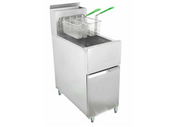Electric vs. Gas Fryers – Which Suits Your Restaurant Best?
Introduction
In the world of commercial restaurant equipment, choosing the right type of fryer can make a big difference in efficiency, cost, and cooking quality. Electric and gas fryers are the two main options—each with distinct advantages and trade‑offs. Whether you're opening a fast‑food joint, a high‑volume kitchen, or simply upgrading your setup in restaurant equipment Dallas, this article breaks down how each fryer type works and which establishment benefits most.
1. How Electric Fryers Work
-
Heating Element: Electric fryers use resistive metal coils or elements submerged in oil. Electric current heats these elements, transferring heat directly to the oil.
-
Temperature Control: Precise thermostats maintain exact temperatures—ideal for delicate frying like tempura or churros.
-
Heat Distribution: Elements are typically immersed or positioned to evenly distribute heat across the oil bath.
-
Setup & Maintenance:
-
Simply plug in and power on—no gas line, ventilation, or pilot lights.
-
Periodically drain oil and descale heating rods for consistent performance.
-
Pros
-
Cleaner installation and operation (no combustion).
-
Precise temperature control and recovery.
-
Safer: no open flame or gas line risks.
-
Ideal for indoor use where gas lines aren’t available.
Cons
-
Higher electric draw can be expensive in high‑volume fryers.
-
Slower heat‑up times compared to gas.
-
Potentially larger carbon footprint depending on electricity source.
2. How Gas Fryers Work
-
Burner System: Gas fryers use natural gas or propane burners below a grease‑proof fry pot.
-
Pilot/Flame Adjustment: Flame size controls heating. Manual valves or thermostats adjust temperature.
-
Heat-Up Speed: Gas burners heat faster and recover heat quickly after adding product.
-
Setup & Maintenance:
-
Needs gas line hookup, adequate ventilation, and flame‑proof surroundings.
-
Burners may need routine cleaning to avoid soot and clogging.
-
Pros
-
Faster heating and oil recovery—perfect for high‑volume environments.
-
Generally lower operating cost if gas utility is cheaper than electricity.
-
Can produce a slightly different flavor profile due to natural combustion.
Cons
-
Requires proper ventilation and safety systems.
-
Open flame risk and gas leak possibilities.
-
Slightly less temperature precision unless high‑end thermostats are installed.
| Feature | Electric Fryer | Gas Fryer |
|---|---|---|
| Heat-up Time | Moderate (5–10 min) | Fast (3–7 min) |
| Temperature Control | High precision | Moderate, unless premium unit |
| Energy Costs | Higher with heavy use | Lower, depending on gas rates |
| Installation Needs | Easy (just plug-in) | Requires gas line & safe ventilation |
| Footprint | Usually compact | Bulkier due to burner & vent requirements |
| Safety Factors | Safer (no flame/leaks) | Requires flame detection & ventilation |
4. What Type of Restaurants Need Which?
-
Quick‑Service, High‑Volume Kitchens
-
Examples: Fast‑food chains, fried‑chicken spots, large‑scale fry bars.
-
Recommendation: Gas fryers—fast heat-up and recovery mean you keep orders moving during peak rush.
-
-
Specialty/Fine‑Dining or Indoor‑Only Venues
-
Examples: Seafood restaurants, upscale eateries, café pastries.
-
Recommendation: Electric fryers shine here—precise control guarantees delicate, consistent results.
-
-
Food Trucks / Mobile Kitchens
-
Examples: Street‑food-fry trucks in restaurant equipment Dallas or nationwide.
-
Recommendation: Electric fryers simplify installation, but propane gas fryers are possible with proper safety gear.
-
-
Small‑Scale or Budget Startups
-
Examples: Cafés, small diners, pop‑ups buying used restaurant equipment.
-
Recommendation: Depending on available utilities—electric fryers or small gas fryers are both realistic options.
-
5. Why Consider Used Restaurant Equipment?
-
Cost‑Savings: Used fryers can cost 40–60% less than new models.
-
Availability: Restaurants in restaurant equipment Dallas often sell fully working used units due to remodeling or closing.
-
Environmental Impact: Extending equipment life reduces waste—an eco‑friendly choice.
-
Warranty & Quality: Look for reputable resellers offering inspection, parts, and short warranties for peace of mind.
6. Final Recommendations
-
You’ll want commercial restaurant equipment that aligns with:
a. Volume & Speed Needs
-
Large plates or big batches → go gas.
-
Lower volume or delicate items → electric.
b. Utility Access & Safety
-
No gas line? Electric it is—just plug and play.
-
Gas available? Ensure proper ventilation and flame safety systems.
c. Budget & Resale Value
-
Used restaurant equipment can be smart for startups. Just ensure proper maintenance history.
-
Factor in long‑term energy costs: electric may be more economical for light use.
d. Kitchen Layout
-
Tight indoor space favors electric units.
-
Gas fryers—plus ventilation hoods—need more space.
-
Conclusion
Choosing between electric and gas fryers affects everything—from cooking precision to operational cost and kitchen safety. While commercial restaurant equipment always requires investment, selecting the right fryer type for your restaurant concept, volume, and utilities will pay dividends in quality and efficiency. Whether you’re outfitting a new spot in restaurant equipment Dallas or evaluating used restaurant equipment, you’ll have the right fryer for your menu and budget.

